In 1849 U.S. Army Major Ripley Arnold, Texas Rangers Colonel Middleton Tate Johnson, and a few soldiers were scouting for a site suitable for a new Army post along the northern frontier of Texas. They stood on a bluff overlooking the confluence of the Clear and West forks of the Trinity River and noted the logistical advantages of the site: Water and timber were close; game was plentiful; the river would be a barrier against attack; the bluff would allow a view for miles. Looking north, they saw on the other side of the river a hillside that was unchanged by human hand: live oak trees, prairie grass.
Their assessment: This is the perfect location.
Fast-forward thirty years. In 1879 John Peter Smith stood on that hillside (which he owned) on the other side of the river and looked south at the bluff on which Arnold and Johnson had stood in 1849. Their Army post had evolved into a town—Smith’s town. His town had grown since he had arrived in 1853, the year the Army abandoned the fort. The town’s population was now six thousand. The town now had a railroad. And a streetcar line. And a three-story hotel. But its only cemetery, located northeast of town near Traders Oak, had been doing business with the Grim Reaper for twenty-nine years. It was filling up with Cowtown’s pioneers. Fort Worth needed a second cemetery.
His assessment: This is the perfect location.
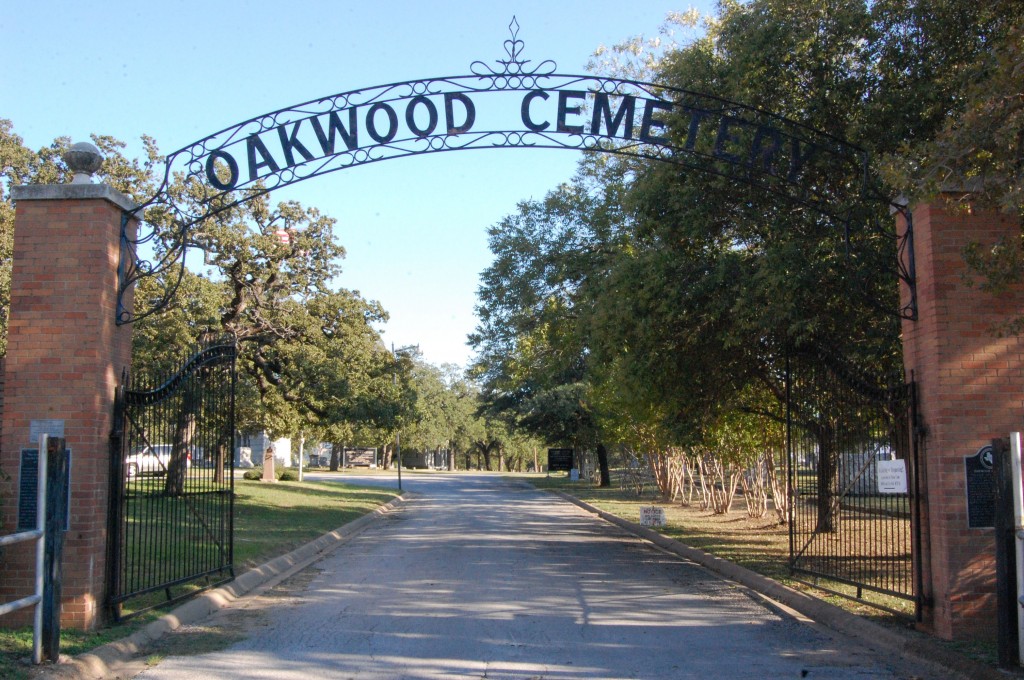 John Peter Smith—one of the town’s largest landowners—donated twenty acres of that hillside on which to locate the new cemetery, which would come to be called “Oakwood Cemetery.”
John Peter Smith—one of the town’s largest landowners—donated twenty acres of that hillside on which to locate the new cemetery, which would come to be called “Oakwood Cemetery.”
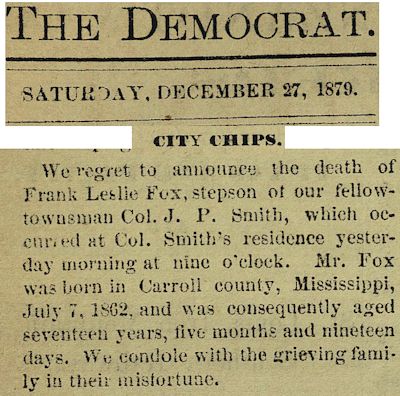
The first person to be buried in the new cemetery? Young Frank L. Fox, who died on December 26, 1879.

Fox was buried on December 28.
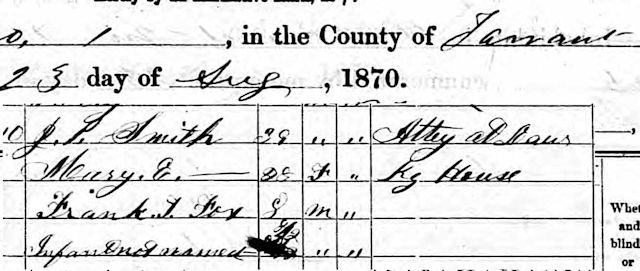
Fox was John Peter Smith’s stepson.
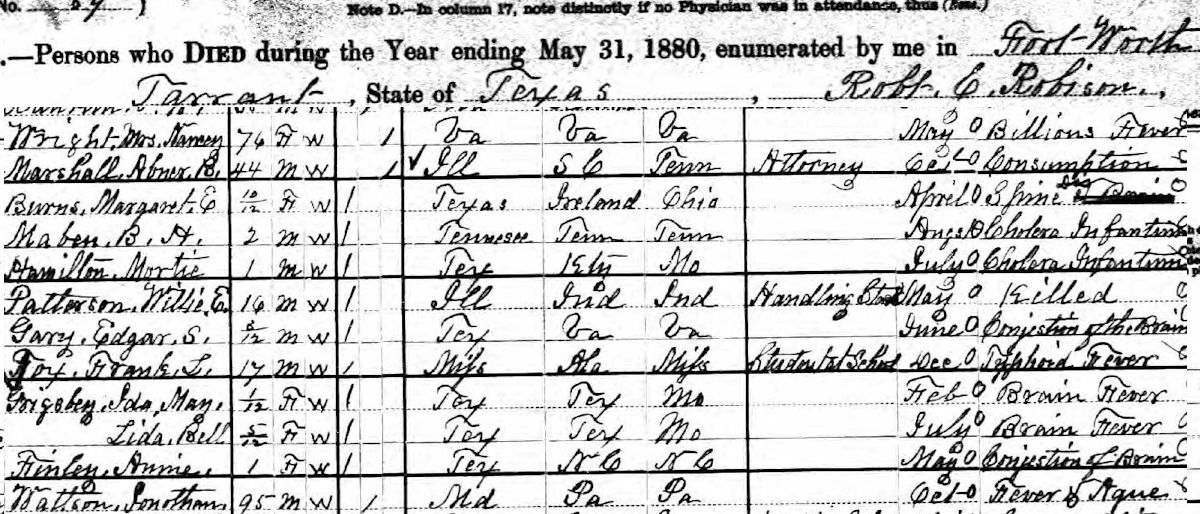 Fox, seventeen, was a student. He died of typhoid fever. Note other common causes of death of the time: bilious fever, cholera, consumption, congestion of the brain, brain fever, fever of ague.
Fox, seventeen, was a student. He died of typhoid fever. Note other common causes of death of the time: bilious fever, cholera, consumption, congestion of the brain, brain fever, fever of ague.
Oakwood Cemetery now covers “over one hundred acres” of land, according to The Story of Oakwood Cemetery, and 140 years of Fort Worth history.
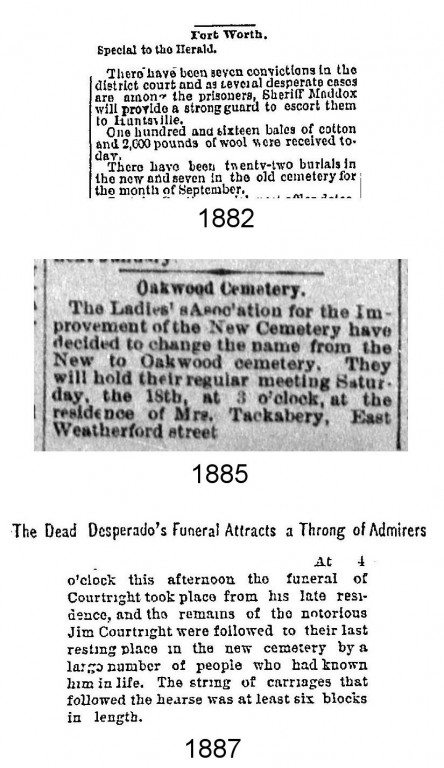
Fort Worth’s first cemetery, Pioneers Rest (1850), was called simply “the city cemetery” until Oakwood was established. Then Pioneers Rest became known as “the old cemetery” and Oakwood as “the new cemetery.” The new cemetery was not named “Oakwood” until 1885, and even after that it was often referred to as “the new cemetery,” as the 1887 clip about Jim Courtright’s funeral shows.
Pioneers Rest did not get its current name until 1909.
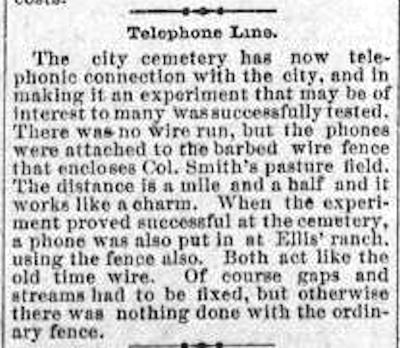 In 1883 Oakwood Cemetery was connected to the city by telephone—using John Peter Smith’s barbed wire fence! Clip is from the May 5, 1883 Fort Worth Gazette.
In 1883 Oakwood Cemetery was connected to the city by telephone—using John Peter Smith’s barbed wire fence! Clip is from the May 5, 1883 Fort Worth Gazette.
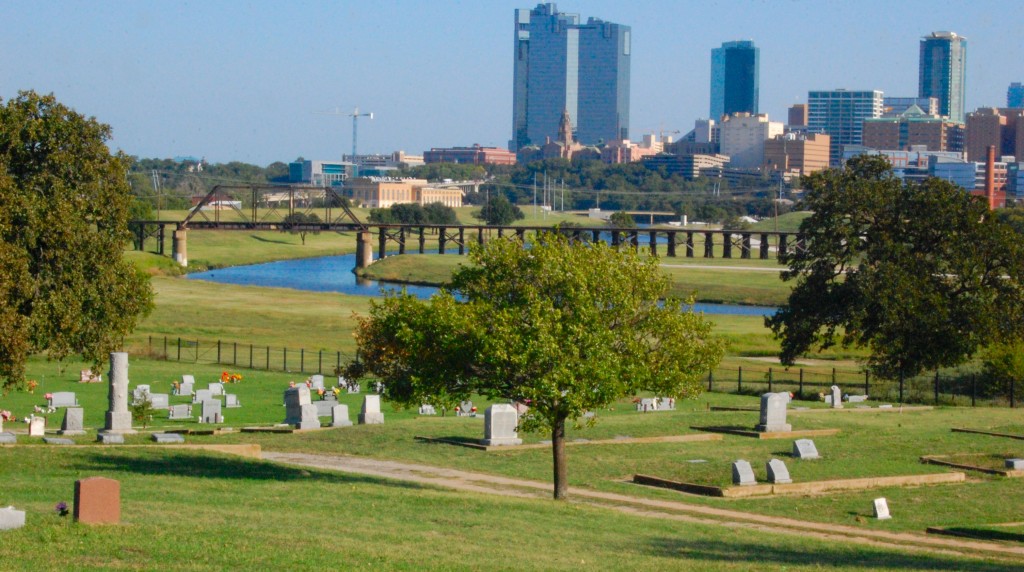 In the early days of Oakwood, Fort Worth was still located mostly on the other side of the Trinity River. Thus, the dearly departed had to cross the Trinity to reach their new address in the afterlife. The Trinity was their River Styx. In the beginning, funerals were held in a home or a church in or near downtown. Then the hearse, drawn by horses, would cross the Trinity at a ford below the courthouse near the confluence and climb the hillside on Cemetery Road to Oakwood. The river was much narrower and shallower before the flood control project of the 1950s-1960s, and after a heavy rain, when the river rose, crossing the river could be a harrowing experience. Sometimes horses—and mourners—in the funeral procession refused to go on. According to local lore, an expression formed in Fort Worth to describe loyal mourners who did not turn back at the ford: “He’s a good friend. He will follow you all the way across the river.”
In the early days of Oakwood, Fort Worth was still located mostly on the other side of the Trinity River. Thus, the dearly departed had to cross the Trinity to reach their new address in the afterlife. The Trinity was their River Styx. In the beginning, funerals were held in a home or a church in or near downtown. Then the hearse, drawn by horses, would cross the Trinity at a ford below the courthouse near the confluence and climb the hillside on Cemetery Road to Oakwood. The river was much narrower and shallower before the flood control project of the 1950s-1960s, and after a heavy rain, when the river rose, crossing the river could be a harrowing experience. Sometimes horses—and mourners—in the funeral procession refused to go on. According to local lore, an expression formed in Fort Worth to describe loyal mourners who did not turn back at the ford: “He’s a good friend. He will follow you all the way across the river.”
Oakwood originally had two subcemeteries:
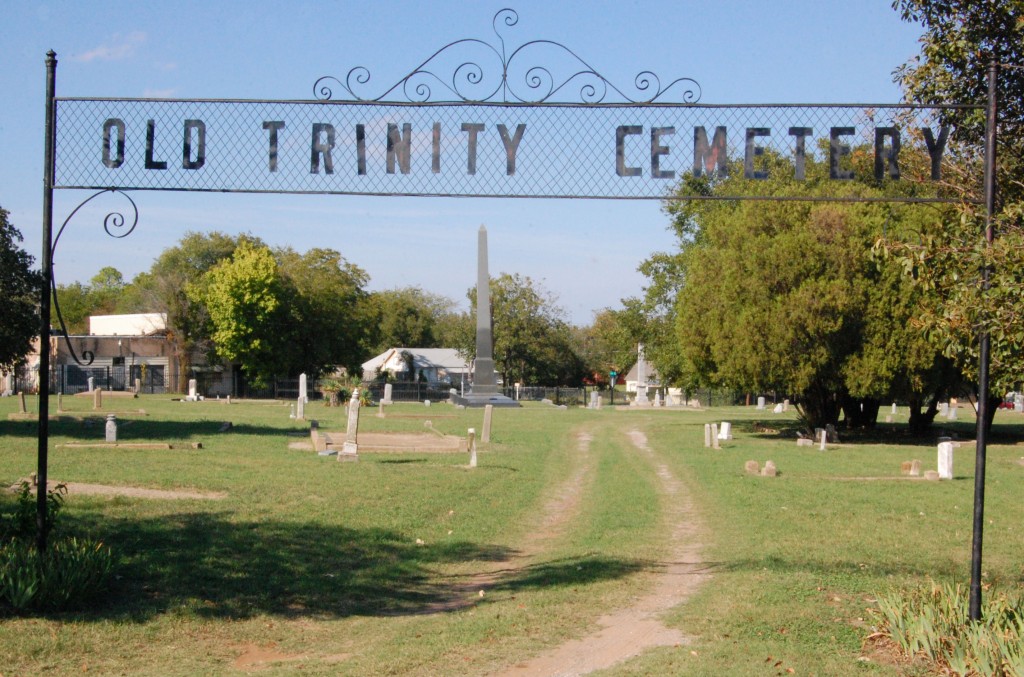 Old Trinity Cemetery for African Americans . . .
Old Trinity Cemetery for African Americans . . .
 and Calvary Cemetery for Catholics.
and Calvary Cemetery for Catholics.
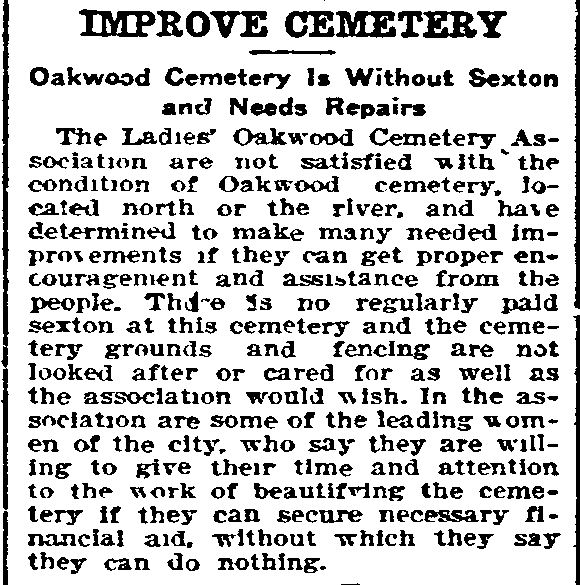 For most of its history Oakwood has been cared for by an association of volunteers.
For most of its history Oakwood has been cared for by an association of volunteers.
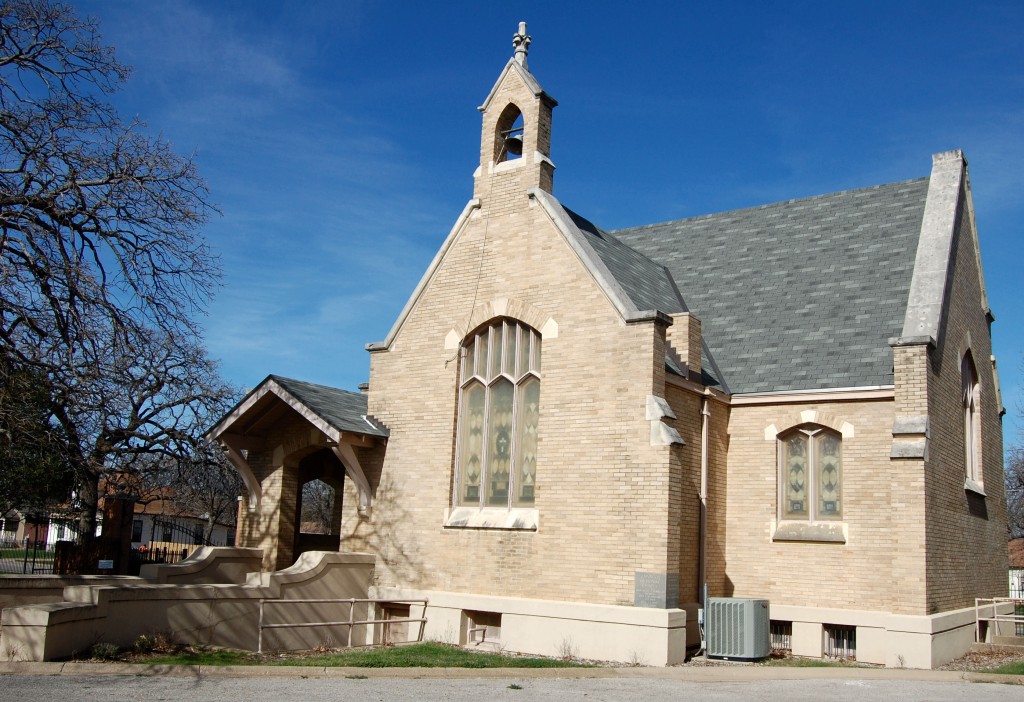 In 1912 the cemetery association raised funds to build Oakwood’s chapel.
In 1912 the cemetery association raised funds to build Oakwood’s chapel.
In the early 1950s Oakwood had a population explosion when Carswell Air Force Base’s main runway was extended, taking in White Settlement’s cemetery. The remains of more than three hundred people were moved to Oakwood. Again according to local lore, under the runway extension today lies a sole holdout: the remains of a man who, before he died, had left orders that, in the words of the old hymn, “I shall not be moved.”
With an estimated population of twenty-eight thousand souls now, Oakwood would rank fifteenth in population among Tarrant County cities. Oakwood, the cemetery that began with John Peter Smith’s twenty acres across the river, is truly a city of the dead.
Styx and Stones (Part 2): If Ghosts Were Guests
Oakwood Cemetery Saints and Sinners Tour






Mike, perhaps check With the Oakwood Directory. The cemetery is only about 66 acres.
Thanks, Melissa. I use the “over one hundred acres” in Harrison’s The Story of Oakwood Cemetery.
Melissa, the historical marker also lists at least 100 acres: https://texashistoricalmarkers.weebly.com/oakwood-cemetery6.html
Love it, as usual, Mike. Thanks for noting the 140th anniversary of the grounds.
Thanks, Debi. And happy new year to all the saints and sinners of Oakwood.
I’m wondering what brain fever is…and fever of ague?
Traci, those are outdated terms relating to (1) inflammation of the brain and (2) fever and paroxysms caused by malaria.
I have several posts on patent medicines and the quaintly named ails they reputedly cured. Links at the bottom of this post.
it was also said of friends” he”ll do to cross the river with” meaning he would stand firm with you in time of need.